FIN210 - Credit Card Debt Traps, Financial Planning & Solutions
VerifiedAdded on 2023/06/12
|10
|2775
|183
Report
AI Summary
This report analyzes the issue of credit card debt and its impact on personal finances. It discusses how credit cards can lead to debt traps due to interest rates, hidden fees, and impulsive spending. The report highlights the importance of financial literacy and planning to avoid these traps, suggesting strategies like budgeting, using debit cards, and understanding credit card terms. It emphasizes that while credit cards offer convenience, they require careful management to prevent financial strain. The report concludes by advocating for informed financial decisions to mitigate the risks associated with credit card usage. Desklib provides similar solved assignments and resources for students.
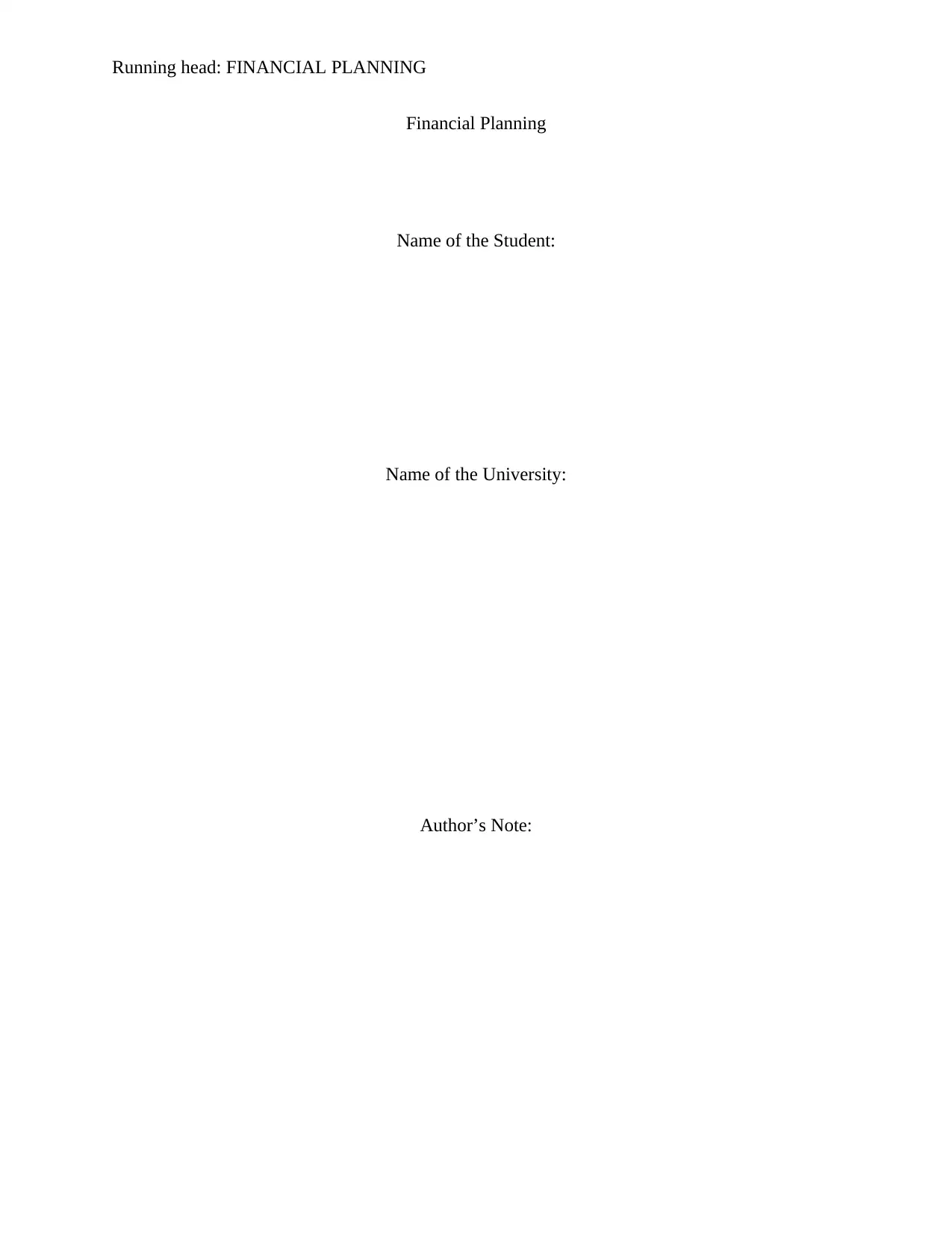
Running head: FINANCIAL PLANNING
Financial Planning
Name of the Student:
Name of the University:
Author’s Note:
Financial Planning
Name of the Student:
Name of the University:
Author’s Note:
Paraphrase This Document
Need a fresh take? Get an instant paraphrase of this document with our AI Paraphraser
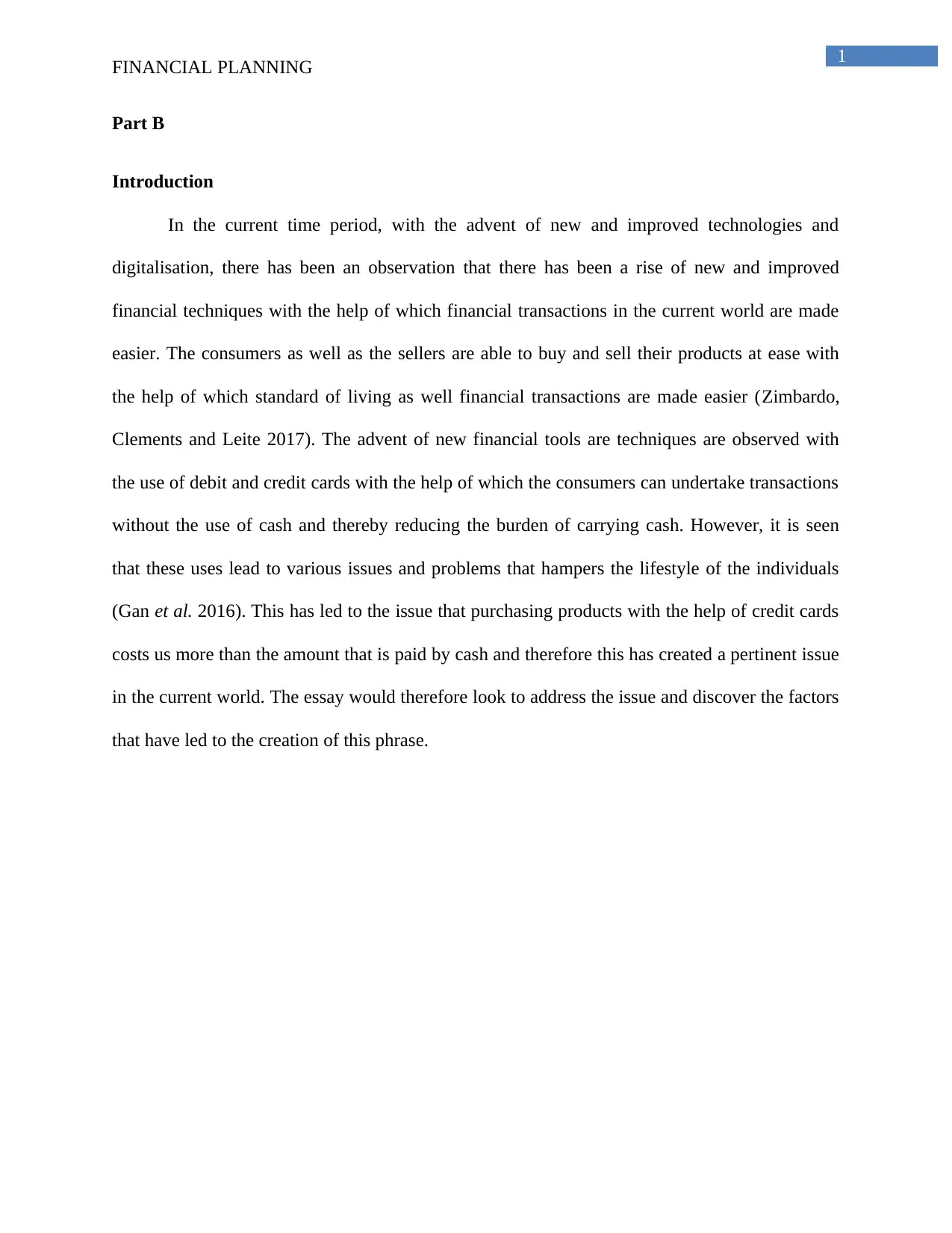
1
FINANCIAL PLANNING
Part B
Introduction
In the current time period, with the advent of new and improved technologies and
digitalisation, there has been an observation that there has been a rise of new and improved
financial techniques with the help of which financial transactions in the current world are made
easier. The consumers as well as the sellers are able to buy and sell their products at ease with
the help of which standard of living as well financial transactions are made easier (Zimbardo,
Clements and Leite 2017). The advent of new financial tools are techniques are observed with
the use of debit and credit cards with the help of which the consumers can undertake transactions
without the use of cash and thereby reducing the burden of carrying cash. However, it is seen
that these uses lead to various issues and problems that hampers the lifestyle of the individuals
(Gan et al. 2016). This has led to the issue that purchasing products with the help of credit cards
costs us more than the amount that is paid by cash and therefore this has created a pertinent issue
in the current world. The essay would therefore look to address the issue and discover the factors
that have led to the creation of this phrase.
FINANCIAL PLANNING
Part B
Introduction
In the current time period, with the advent of new and improved technologies and
digitalisation, there has been an observation that there has been a rise of new and improved
financial techniques with the help of which financial transactions in the current world are made
easier. The consumers as well as the sellers are able to buy and sell their products at ease with
the help of which standard of living as well financial transactions are made easier (Zimbardo,
Clements and Leite 2017). The advent of new financial tools are techniques are observed with
the use of debit and credit cards with the help of which the consumers can undertake transactions
without the use of cash and thereby reducing the burden of carrying cash. However, it is seen
that these uses lead to various issues and problems that hampers the lifestyle of the individuals
(Gan et al. 2016). This has led to the issue that purchasing products with the help of credit cards
costs us more than the amount that is paid by cash and therefore this has created a pertinent issue
in the current world. The essay would therefore look to address the issue and discover the factors
that have led to the creation of this phrase.
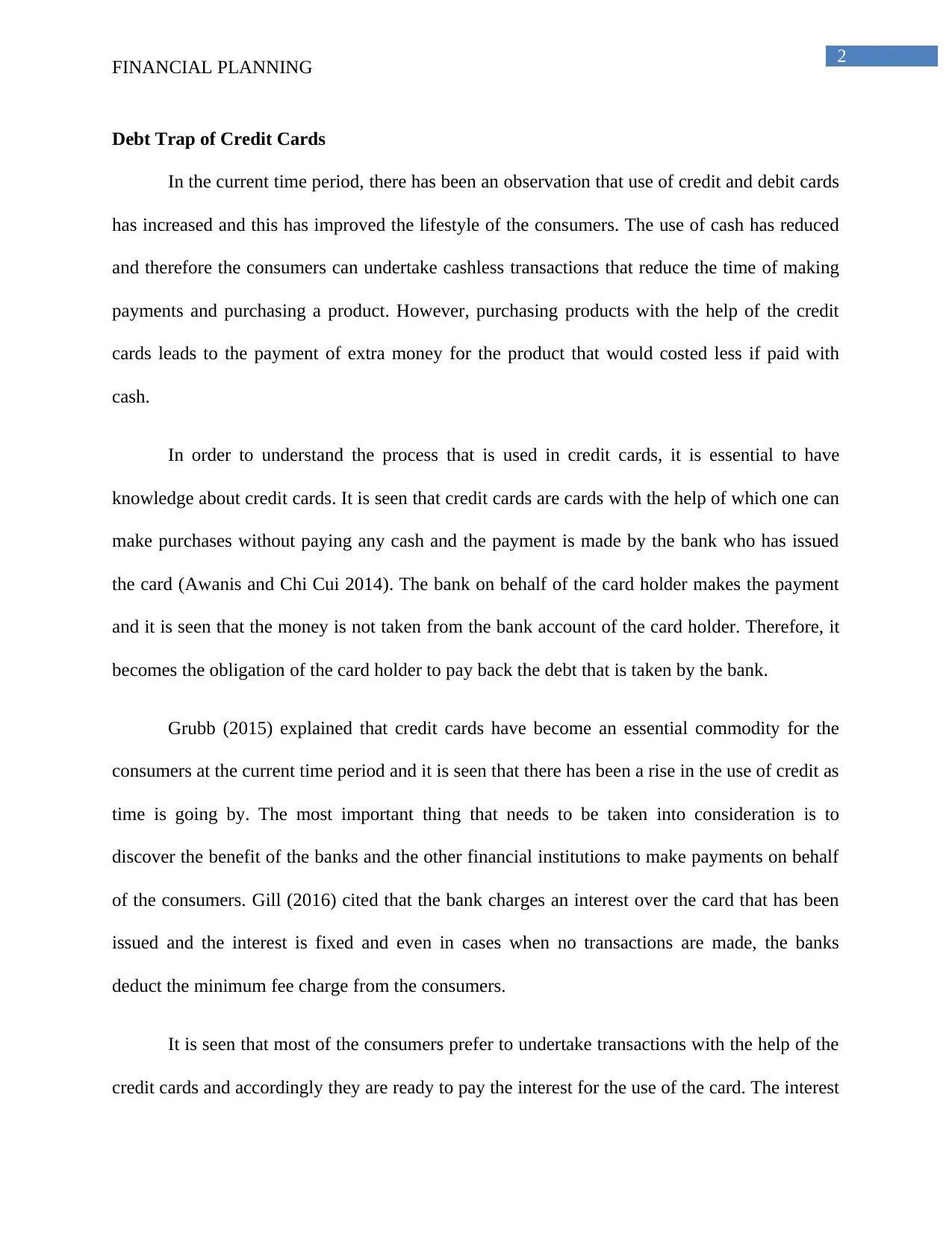
2
FINANCIAL PLANNING
Debt Trap of Credit Cards
In the current time period, there has been an observation that use of credit and debit cards
has increased and this has improved the lifestyle of the consumers. The use of cash has reduced
and therefore the consumers can undertake cashless transactions that reduce the time of making
payments and purchasing a product. However, purchasing products with the help of the credit
cards leads to the payment of extra money for the product that would costed less if paid with
cash.
In order to understand the process that is used in credit cards, it is essential to have
knowledge about credit cards. It is seen that credit cards are cards with the help of which one can
make purchases without paying any cash and the payment is made by the bank who has issued
the card (Awanis and Chi Cui 2014). The bank on behalf of the card holder makes the payment
and it is seen that the money is not taken from the bank account of the card holder. Therefore, it
becomes the obligation of the card holder to pay back the debt that is taken by the bank.
Grubb (2015) explained that credit cards have become an essential commodity for the
consumers at the current time period and it is seen that there has been a rise in the use of credit as
time is going by. The most important thing that needs to be taken into consideration is to
discover the benefit of the banks and the other financial institutions to make payments on behalf
of the consumers. Gill (2016) cited that the bank charges an interest over the card that has been
issued and the interest is fixed and even in cases when no transactions are made, the banks
deduct the minimum fee charge from the consumers.
It is seen that most of the consumers prefer to undertake transactions with the help of the
credit cards and accordingly they are ready to pay the interest for the use of the card. The interest
FINANCIAL PLANNING
Debt Trap of Credit Cards
In the current time period, there has been an observation that use of credit and debit cards
has increased and this has improved the lifestyle of the consumers. The use of cash has reduced
and therefore the consumers can undertake cashless transactions that reduce the time of making
payments and purchasing a product. However, purchasing products with the help of the credit
cards leads to the payment of extra money for the product that would costed less if paid with
cash.
In order to understand the process that is used in credit cards, it is essential to have
knowledge about credit cards. It is seen that credit cards are cards with the help of which one can
make purchases without paying any cash and the payment is made by the bank who has issued
the card (Awanis and Chi Cui 2014). The bank on behalf of the card holder makes the payment
and it is seen that the money is not taken from the bank account of the card holder. Therefore, it
becomes the obligation of the card holder to pay back the debt that is taken by the bank.
Grubb (2015) explained that credit cards have become an essential commodity for the
consumers at the current time period and it is seen that there has been a rise in the use of credit as
time is going by. The most important thing that needs to be taken into consideration is to
discover the benefit of the banks and the other financial institutions to make payments on behalf
of the consumers. Gill (2016) cited that the bank charges an interest over the card that has been
issued and the interest is fixed and even in cases when no transactions are made, the banks
deduct the minimum fee charge from the consumers.
It is seen that most of the consumers prefer to undertake transactions with the help of the
credit cards and accordingly they are ready to pay the interest for the use of the card. The interest
⊘ This is a preview!⊘
Do you want full access?
Subscribe today to unlock all pages.

Trusted by 1+ million students worldwide
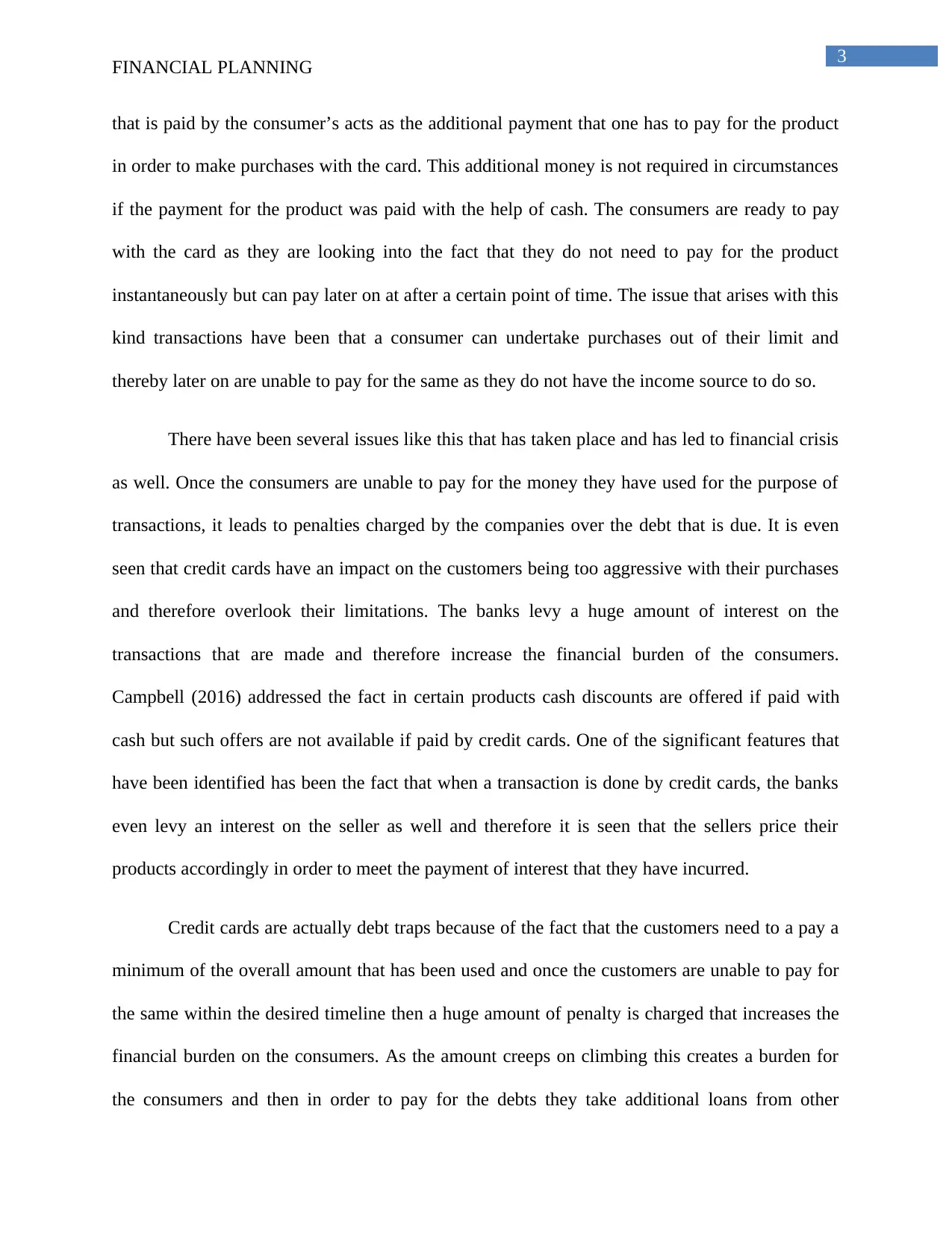
3
FINANCIAL PLANNING
that is paid by the consumer’s acts as the additional payment that one has to pay for the product
in order to make purchases with the card. This additional money is not required in circumstances
if the payment for the product was paid with the help of cash. The consumers are ready to pay
with the card as they are looking into the fact that they do not need to pay for the product
instantaneously but can pay later on at after a certain point of time. The issue that arises with this
kind transactions have been that a consumer can undertake purchases out of their limit and
thereby later on are unable to pay for the same as they do not have the income source to do so.
There have been several issues like this that has taken place and has led to financial crisis
as well. Once the consumers are unable to pay for the money they have used for the purpose of
transactions, it leads to penalties charged by the companies over the debt that is due. It is even
seen that credit cards have an impact on the customers being too aggressive with their purchases
and therefore overlook their limitations. The banks levy a huge amount of interest on the
transactions that are made and therefore increase the financial burden of the consumers.
Campbell (2016) addressed the fact in certain products cash discounts are offered if paid with
cash but such offers are not available if paid by credit cards. One of the significant features that
have been identified has been the fact that when a transaction is done by credit cards, the banks
even levy an interest on the seller as well and therefore it is seen that the sellers price their
products accordingly in order to meet the payment of interest that they have incurred.
Credit cards are actually debt traps because of the fact that the customers need to a pay a
minimum of the overall amount that has been used and once the customers are unable to pay for
the same within the desired timeline then a huge amount of penalty is charged that increases the
financial burden on the consumers. As the amount creeps on climbing this creates a burden for
the consumers and then in order to pay for the debts they take additional loans from other
FINANCIAL PLANNING
that is paid by the consumer’s acts as the additional payment that one has to pay for the product
in order to make purchases with the card. This additional money is not required in circumstances
if the payment for the product was paid with the help of cash. The consumers are ready to pay
with the card as they are looking into the fact that they do not need to pay for the product
instantaneously but can pay later on at after a certain point of time. The issue that arises with this
kind transactions have been that a consumer can undertake purchases out of their limit and
thereby later on are unable to pay for the same as they do not have the income source to do so.
There have been several issues like this that has taken place and has led to financial crisis
as well. Once the consumers are unable to pay for the money they have used for the purpose of
transactions, it leads to penalties charged by the companies over the debt that is due. It is even
seen that credit cards have an impact on the customers being too aggressive with their purchases
and therefore overlook their limitations. The banks levy a huge amount of interest on the
transactions that are made and therefore increase the financial burden of the consumers.
Campbell (2016) addressed the fact in certain products cash discounts are offered if paid with
cash but such offers are not available if paid by credit cards. One of the significant features that
have been identified has been the fact that when a transaction is done by credit cards, the banks
even levy an interest on the seller as well and therefore it is seen that the sellers price their
products accordingly in order to meet the payment of interest that they have incurred.
Credit cards are actually debt traps because of the fact that the customers need to a pay a
minimum of the overall amount that has been used and once the customers are unable to pay for
the same within the desired timeline then a huge amount of penalty is charged that increases the
financial burden on the consumers. As the amount creeps on climbing this creates a burden for
the consumers and then in order to pay for the debts they take additional loans from other
Paraphrase This Document
Need a fresh take? Get an instant paraphrase of this document with our AI Paraphraser
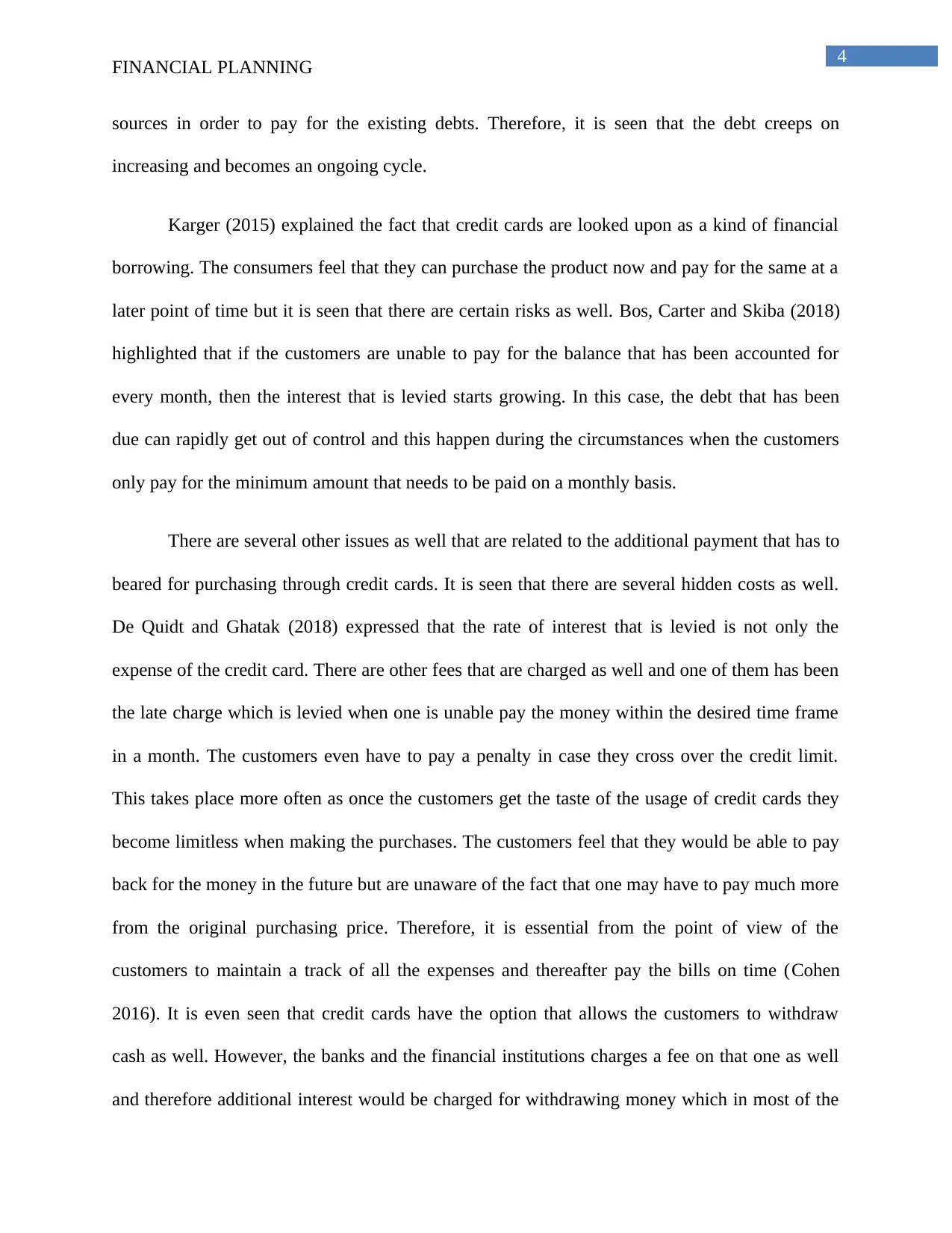
4
FINANCIAL PLANNING
sources in order to pay for the existing debts. Therefore, it is seen that the debt creeps on
increasing and becomes an ongoing cycle.
Karger (2015) explained the fact that credit cards are looked upon as a kind of financial
borrowing. The consumers feel that they can purchase the product now and pay for the same at a
later point of time but it is seen that there are certain risks as well. Bos, Carter and Skiba (2018)
highlighted that if the customers are unable to pay for the balance that has been accounted for
every month, then the interest that is levied starts growing. In this case, the debt that has been
due can rapidly get out of control and this happen during the circumstances when the customers
only pay for the minimum amount that needs to be paid on a monthly basis.
There are several other issues as well that are related to the additional payment that has to
beared for purchasing through credit cards. It is seen that there are several hidden costs as well.
De Quidt and Ghatak (2018) expressed that the rate of interest that is levied is not only the
expense of the credit card. There are other fees that are charged as well and one of them has been
the late charge which is levied when one is unable pay the money within the desired time frame
in a month. The customers even have to pay a penalty in case they cross over the credit limit.
This takes place more often as once the customers get the taste of the usage of credit cards they
become limitless when making the purchases. The customers feel that they would be able to pay
back for the money in the future but are unaware of the fact that one may have to pay much more
from the original purchasing price. Therefore, it is essential from the point of view of the
customers to maintain a track of all the expenses and thereafter pay the bills on time (Cohen
2016). It is even seen that credit cards have the option that allows the customers to withdraw
cash as well. However, the banks and the financial institutions charges a fee on that one as well
and therefore additional interest would be charged for withdrawing money which in most of the
FINANCIAL PLANNING
sources in order to pay for the existing debts. Therefore, it is seen that the debt creeps on
increasing and becomes an ongoing cycle.
Karger (2015) explained the fact that credit cards are looked upon as a kind of financial
borrowing. The consumers feel that they can purchase the product now and pay for the same at a
later point of time but it is seen that there are certain risks as well. Bos, Carter and Skiba (2018)
highlighted that if the customers are unable to pay for the balance that has been accounted for
every month, then the interest that is levied starts growing. In this case, the debt that has been
due can rapidly get out of control and this happen during the circumstances when the customers
only pay for the minimum amount that needs to be paid on a monthly basis.
There are several other issues as well that are related to the additional payment that has to
beared for purchasing through credit cards. It is seen that there are several hidden costs as well.
De Quidt and Ghatak (2018) expressed that the rate of interest that is levied is not only the
expense of the credit card. There are other fees that are charged as well and one of them has been
the late charge which is levied when one is unable pay the money within the desired time frame
in a month. The customers even have to pay a penalty in case they cross over the credit limit.
This takes place more often as once the customers get the taste of the usage of credit cards they
become limitless when making the purchases. The customers feel that they would be able to pay
back for the money in the future but are unaware of the fact that one may have to pay much more
from the original purchasing price. Therefore, it is essential from the point of view of the
customers to maintain a track of all the expenses and thereafter pay the bills on time (Cohen
2016). It is even seen that credit cards have the option that allows the customers to withdraw
cash as well. However, the banks and the financial institutions charges a fee on that one as well
and therefore additional interest would be charged for withdrawing money which in most of the
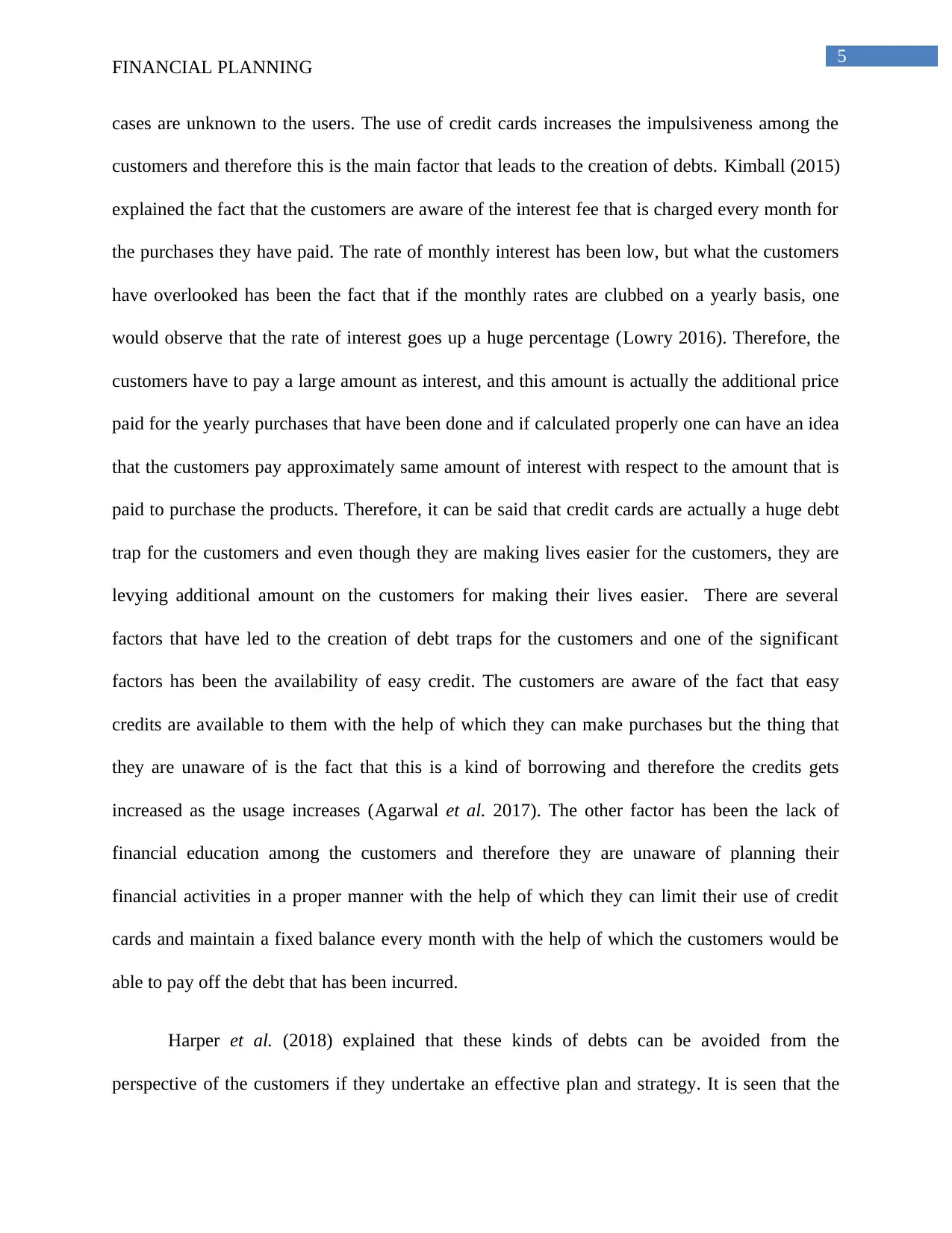
5
FINANCIAL PLANNING
cases are unknown to the users. The use of credit cards increases the impulsiveness among the
customers and therefore this is the main factor that leads to the creation of debts. Kimball (2015)
explained the fact that the customers are aware of the interest fee that is charged every month for
the purchases they have paid. The rate of monthly interest has been low, but what the customers
have overlooked has been the fact that if the monthly rates are clubbed on a yearly basis, one
would observe that the rate of interest goes up a huge percentage (Lowry 2016). Therefore, the
customers have to pay a large amount as interest, and this amount is actually the additional price
paid for the yearly purchases that have been done and if calculated properly one can have an idea
that the customers pay approximately same amount of interest with respect to the amount that is
paid to purchase the products. Therefore, it can be said that credit cards are actually a huge debt
trap for the customers and even though they are making lives easier for the customers, they are
levying additional amount on the customers for making their lives easier. There are several
factors that have led to the creation of debt traps for the customers and one of the significant
factors has been the availability of easy credit. The customers are aware of the fact that easy
credits are available to them with the help of which they can make purchases but the thing that
they are unaware of is the fact that this is a kind of borrowing and therefore the credits gets
increased as the usage increases (Agarwal et al. 2017). The other factor has been the lack of
financial education among the customers and therefore they are unaware of planning their
financial activities in a proper manner with the help of which they can limit their use of credit
cards and maintain a fixed balance every month with the help of which the customers would be
able to pay off the debt that has been incurred.
Harper et al. (2018) explained that these kinds of debts can be avoided from the
perspective of the customers if they undertake an effective plan and strategy. It is seen that the
FINANCIAL PLANNING
cases are unknown to the users. The use of credit cards increases the impulsiveness among the
customers and therefore this is the main factor that leads to the creation of debts. Kimball (2015)
explained the fact that the customers are aware of the interest fee that is charged every month for
the purchases they have paid. The rate of monthly interest has been low, but what the customers
have overlooked has been the fact that if the monthly rates are clubbed on a yearly basis, one
would observe that the rate of interest goes up a huge percentage (Lowry 2016). Therefore, the
customers have to pay a large amount as interest, and this amount is actually the additional price
paid for the yearly purchases that have been done and if calculated properly one can have an idea
that the customers pay approximately same amount of interest with respect to the amount that is
paid to purchase the products. Therefore, it can be said that credit cards are actually a huge debt
trap for the customers and even though they are making lives easier for the customers, they are
levying additional amount on the customers for making their lives easier. There are several
factors that have led to the creation of debt traps for the customers and one of the significant
factors has been the availability of easy credit. The customers are aware of the fact that easy
credits are available to them with the help of which they can make purchases but the thing that
they are unaware of is the fact that this is a kind of borrowing and therefore the credits gets
increased as the usage increases (Agarwal et al. 2017). The other factor has been the lack of
financial education among the customers and therefore they are unaware of planning their
financial activities in a proper manner with the help of which they can limit their use of credit
cards and maintain a fixed balance every month with the help of which the customers would be
able to pay off the debt that has been incurred.
Harper et al. (2018) explained that these kinds of debts can be avoided from the
perspective of the customers if they undertake an effective plan and strategy. It is seen that the
⊘ This is a preview!⊘
Do you want full access?
Subscribe today to unlock all pages.

Trusted by 1+ million students worldwide
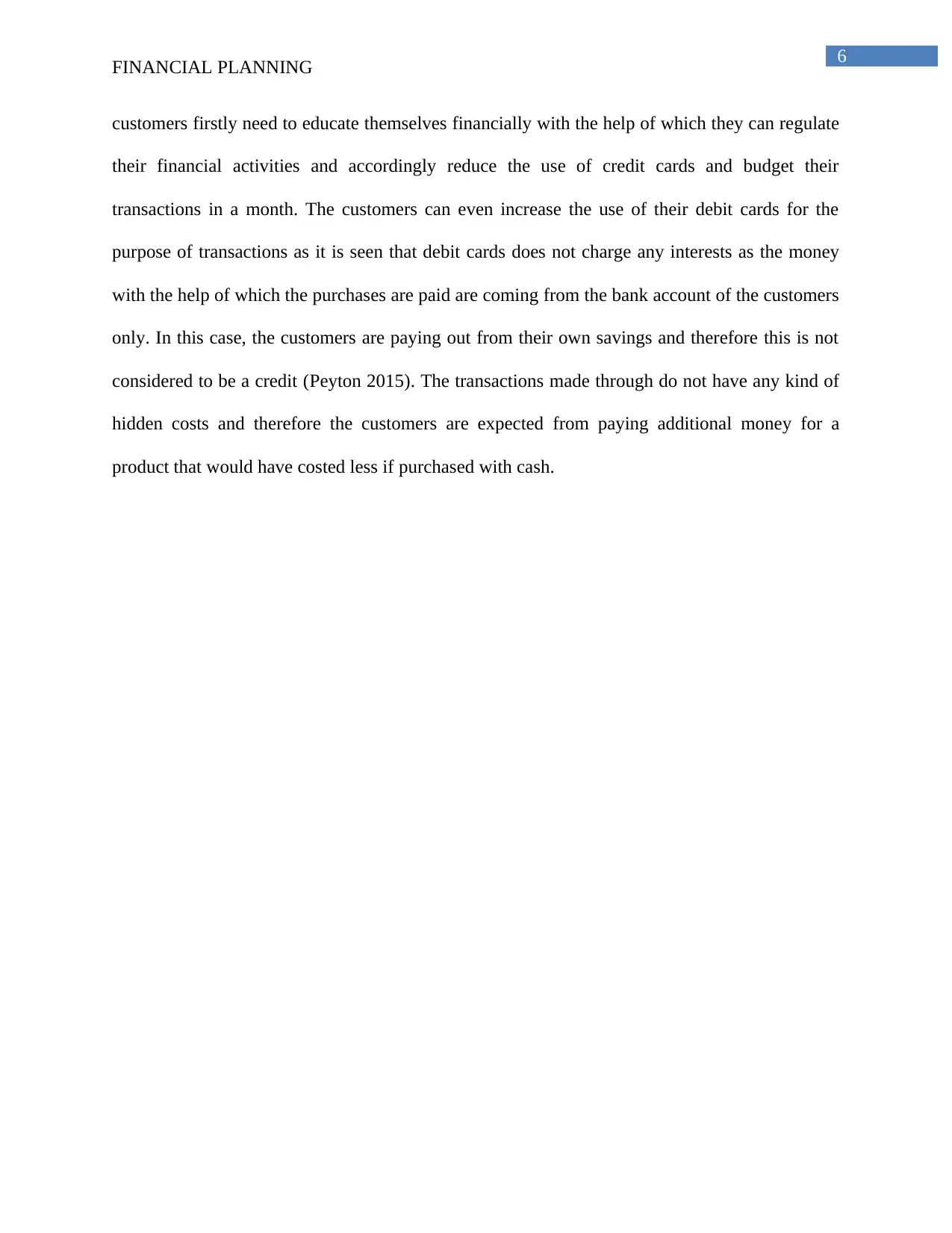
6
FINANCIAL PLANNING
customers firstly need to educate themselves financially with the help of which they can regulate
their financial activities and accordingly reduce the use of credit cards and budget their
transactions in a month. The customers can even increase the use of their debit cards for the
purpose of transactions as it is seen that debit cards does not charge any interests as the money
with the help of which the purchases are paid are coming from the bank account of the customers
only. In this case, the customers are paying out from their own savings and therefore this is not
considered to be a credit (Peyton 2015). The transactions made through do not have any kind of
hidden costs and therefore the customers are expected from paying additional money for a
product that would have costed less if purchased with cash.
FINANCIAL PLANNING
customers firstly need to educate themselves financially with the help of which they can regulate
their financial activities and accordingly reduce the use of credit cards and budget their
transactions in a month. The customers can even increase the use of their debit cards for the
purpose of transactions as it is seen that debit cards does not charge any interests as the money
with the help of which the purchases are paid are coming from the bank account of the customers
only. In this case, the customers are paying out from their own savings and therefore this is not
considered to be a credit (Peyton 2015). The transactions made through do not have any kind of
hidden costs and therefore the customers are expected from paying additional money for a
product that would have costed less if purchased with cash.
Paraphrase This Document
Need a fresh take? Get an instant paraphrase of this document with our AI Paraphraser
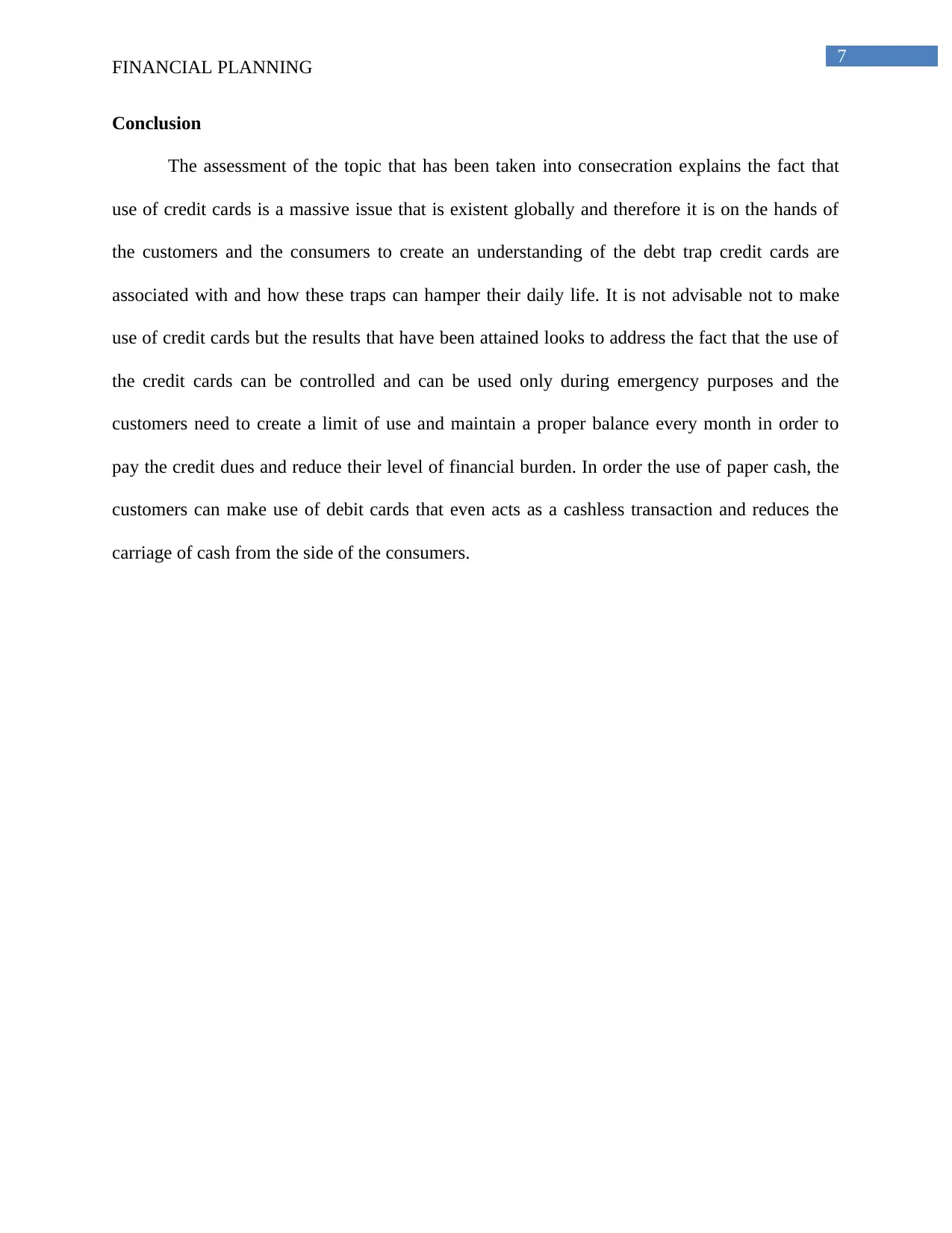
7
FINANCIAL PLANNING
Conclusion
The assessment of the topic that has been taken into consecration explains the fact that
use of credit cards is a massive issue that is existent globally and therefore it is on the hands of
the customers and the consumers to create an understanding of the debt trap credit cards are
associated with and how these traps can hamper their daily life. It is not advisable not to make
use of credit cards but the results that have been attained looks to address the fact that the use of
the credit cards can be controlled and can be used only during emergency purposes and the
customers need to create a limit of use and maintain a proper balance every month in order to
pay the credit dues and reduce their level of financial burden. In order the use of paper cash, the
customers can make use of debit cards that even acts as a cashless transaction and reduces the
carriage of cash from the side of the consumers.
FINANCIAL PLANNING
Conclusion
The assessment of the topic that has been taken into consecration explains the fact that
use of credit cards is a massive issue that is existent globally and therefore it is on the hands of
the customers and the consumers to create an understanding of the debt trap credit cards are
associated with and how these traps can hamper their daily life. It is not advisable not to make
use of credit cards but the results that have been attained looks to address the fact that the use of
the credit cards can be controlled and can be used only during emergency purposes and the
customers need to create a limit of use and maintain a proper balance every month in order to
pay the credit dues and reduce their level of financial burden. In order the use of paper cash, the
customers can make use of debit cards that even acts as a cashless transaction and reduces the
carriage of cash from the side of the consumers.
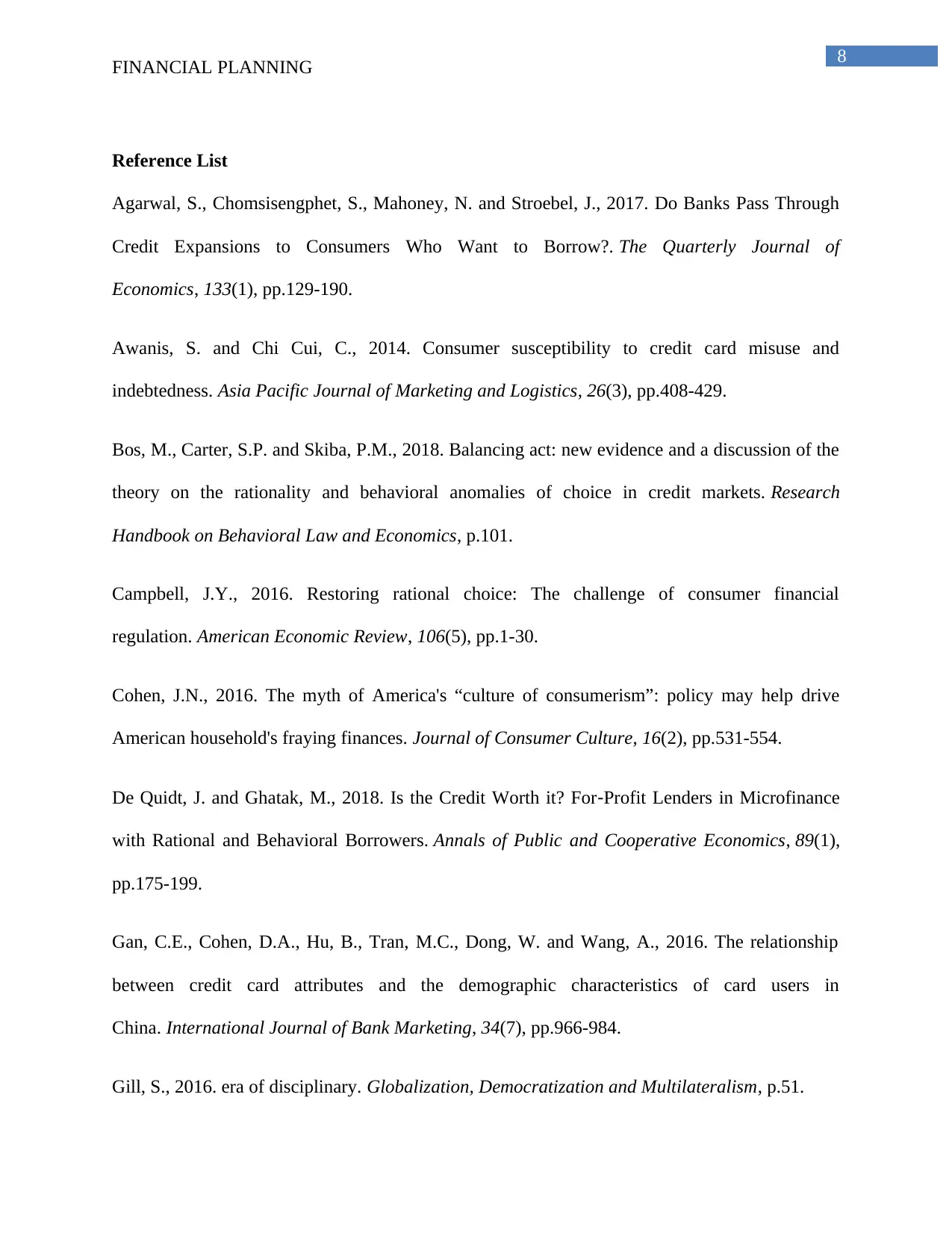
8
FINANCIAL PLANNING
Reference List
Agarwal, S., Chomsisengphet, S., Mahoney, N. and Stroebel, J., 2017. Do Banks Pass Through
Credit Expansions to Consumers Who Want to Borrow?. The Quarterly Journal of
Economics, 133(1), pp.129-190.
Awanis, S. and Chi Cui, C., 2014. Consumer susceptibility to credit card misuse and
indebtedness. Asia Pacific Journal of Marketing and Logistics, 26(3), pp.408-429.
Bos, M., Carter, S.P. and Skiba, P.M., 2018. Balancing act: new evidence and a discussion of the
theory on the rationality and behavioral anomalies of choice in credit markets. Research
Handbook on Behavioral Law and Economics, p.101.
Campbell, J.Y., 2016. Restoring rational choice: The challenge of consumer financial
regulation. American Economic Review, 106(5), pp.1-30.
Cohen, J.N., 2016. The myth of America's “culture of consumerism”: policy may help drive
American household's fraying finances. Journal of Consumer Culture, 16(2), pp.531-554.
De Quidt, J. and Ghatak, M., 2018. Is the Credit Worth it? For‐Profit Lenders in Microfinance
with Rational and Behavioral Borrowers. Annals of Public and Cooperative Economics, 89(1),
pp.175-199.
Gan, C.E., Cohen, D.A., Hu, B., Tran, M.C., Dong, W. and Wang, A., 2016. The relationship
between credit card attributes and the demographic characteristics of card users in
China. International Journal of Bank Marketing, 34(7), pp.966-984.
Gill, S., 2016. era of disciplinary. Globalization, Democratization and Multilateralism, p.51.
FINANCIAL PLANNING
Reference List
Agarwal, S., Chomsisengphet, S., Mahoney, N. and Stroebel, J., 2017. Do Banks Pass Through
Credit Expansions to Consumers Who Want to Borrow?. The Quarterly Journal of
Economics, 133(1), pp.129-190.
Awanis, S. and Chi Cui, C., 2014. Consumer susceptibility to credit card misuse and
indebtedness. Asia Pacific Journal of Marketing and Logistics, 26(3), pp.408-429.
Bos, M., Carter, S.P. and Skiba, P.M., 2018. Balancing act: new evidence and a discussion of the
theory on the rationality and behavioral anomalies of choice in credit markets. Research
Handbook on Behavioral Law and Economics, p.101.
Campbell, J.Y., 2016. Restoring rational choice: The challenge of consumer financial
regulation. American Economic Review, 106(5), pp.1-30.
Cohen, J.N., 2016. The myth of America's “culture of consumerism”: policy may help drive
American household's fraying finances. Journal of Consumer Culture, 16(2), pp.531-554.
De Quidt, J. and Ghatak, M., 2018. Is the Credit Worth it? For‐Profit Lenders in Microfinance
with Rational and Behavioral Borrowers. Annals of Public and Cooperative Economics, 89(1),
pp.175-199.
Gan, C.E., Cohen, D.A., Hu, B., Tran, M.C., Dong, W. and Wang, A., 2016. The relationship
between credit card attributes and the demographic characteristics of card users in
China. International Journal of Bank Marketing, 34(7), pp.966-984.
Gill, S., 2016. era of disciplinary. Globalization, Democratization and Multilateralism, p.51.
⊘ This is a preview!⊘
Do you want full access?
Subscribe today to unlock all pages.

Trusted by 1+ million students worldwide
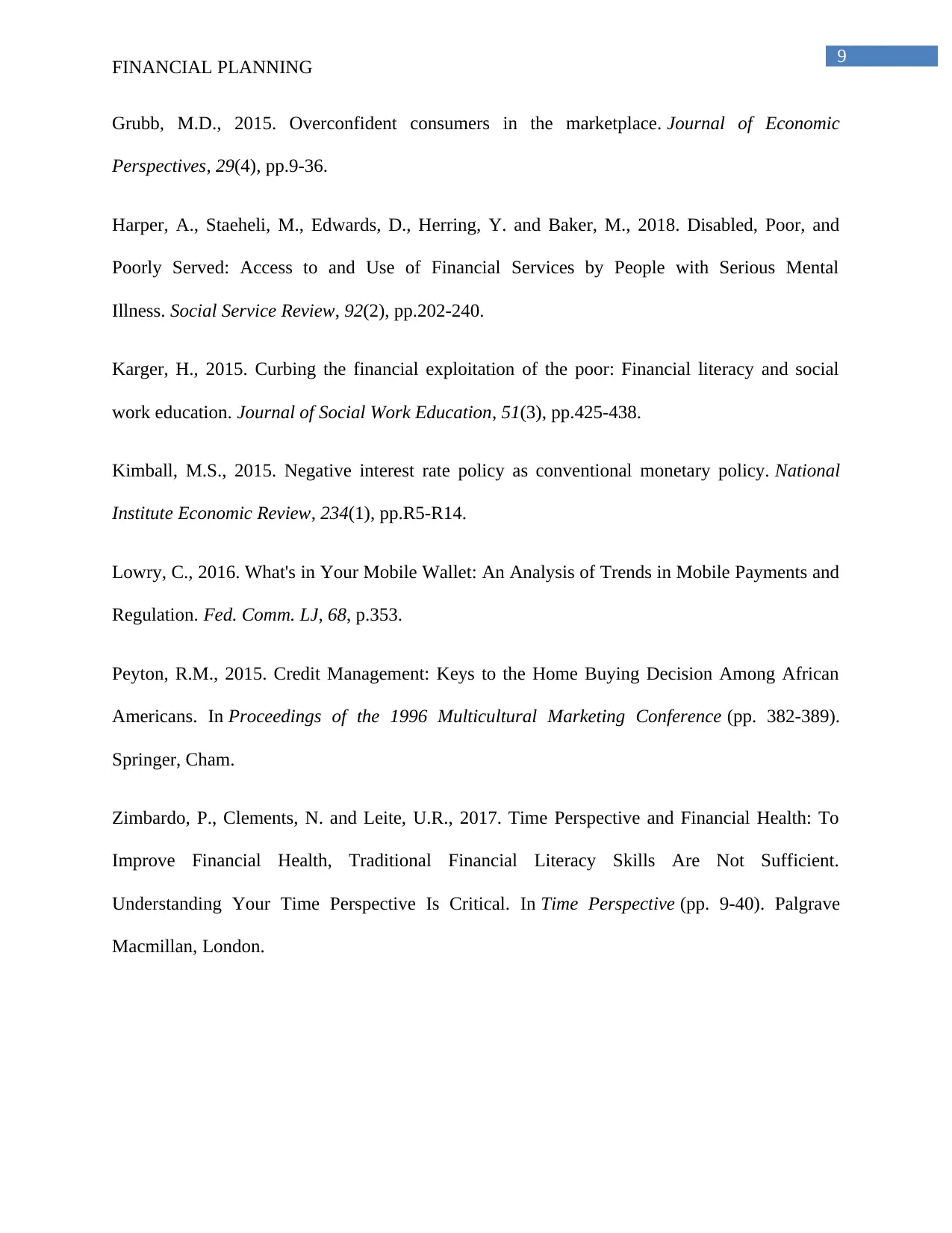
9
FINANCIAL PLANNING
Grubb, M.D., 2015. Overconfident consumers in the marketplace. Journal of Economic
Perspectives, 29(4), pp.9-36.
Harper, A., Staeheli, M., Edwards, D., Herring, Y. and Baker, M., 2018. Disabled, Poor, and
Poorly Served: Access to and Use of Financial Services by People with Serious Mental
Illness. Social Service Review, 92(2), pp.202-240.
Karger, H., 2015. Curbing the financial exploitation of the poor: Financial literacy and social
work education. Journal of Social Work Education, 51(3), pp.425-438.
Kimball, M.S., 2015. Negative interest rate policy as conventional monetary policy. National
Institute Economic Review, 234(1), pp.R5-R14.
Lowry, C., 2016. What's in Your Mobile Wallet: An Analysis of Trends in Mobile Payments and
Regulation. Fed. Comm. LJ, 68, p.353.
Peyton, R.M., 2015. Credit Management: Keys to the Home Buying Decision Among African
Americans. In Proceedings of the 1996 Multicultural Marketing Conference (pp. 382-389).
Springer, Cham.
Zimbardo, P., Clements, N. and Leite, U.R., 2017. Time Perspective and Financial Health: To
Improve Financial Health, Traditional Financial Literacy Skills Are Not Sufficient.
Understanding Your Time Perspective Is Critical. In Time Perspective (pp. 9-40). Palgrave
Macmillan, London.
FINANCIAL PLANNING
Grubb, M.D., 2015. Overconfident consumers in the marketplace. Journal of Economic
Perspectives, 29(4), pp.9-36.
Harper, A., Staeheli, M., Edwards, D., Herring, Y. and Baker, M., 2018. Disabled, Poor, and
Poorly Served: Access to and Use of Financial Services by People with Serious Mental
Illness. Social Service Review, 92(2), pp.202-240.
Karger, H., 2015. Curbing the financial exploitation of the poor: Financial literacy and social
work education. Journal of Social Work Education, 51(3), pp.425-438.
Kimball, M.S., 2015. Negative interest rate policy as conventional monetary policy. National
Institute Economic Review, 234(1), pp.R5-R14.
Lowry, C., 2016. What's in Your Mobile Wallet: An Analysis of Trends in Mobile Payments and
Regulation. Fed. Comm. LJ, 68, p.353.
Peyton, R.M., 2015. Credit Management: Keys to the Home Buying Decision Among African
Americans. In Proceedings of the 1996 Multicultural Marketing Conference (pp. 382-389).
Springer, Cham.
Zimbardo, P., Clements, N. and Leite, U.R., 2017. Time Perspective and Financial Health: To
Improve Financial Health, Traditional Financial Literacy Skills Are Not Sufficient.
Understanding Your Time Perspective Is Critical. In Time Perspective (pp. 9-40). Palgrave
Macmillan, London.
1 out of 10
Related Documents
Your All-in-One AI-Powered Toolkit for Academic Success.
+13062052269
info@desklib.com
Available 24*7 on WhatsApp / Email
![[object Object]](/_next/static/media/star-bottom.7253800d.svg)
Unlock your academic potential
Copyright © 2020–2025 A2Z Services. All Rights Reserved. Developed and managed by ZUCOL.





